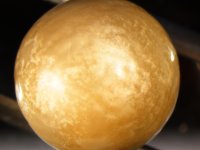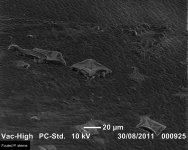Lagoon Island Pearls
Well-known member
- Joined
- Dec 8, 2009
- Messages
- 2,142
There remains confusion whether sand is implicated in the formation of natural pearls.
For over a century, the myth has been most pearls are formed around grains of sand. This is a myth.
It's been reported in more recent times that grains of sand are not implicated in pearl formation. This is also a myth.
Although there are numerous sub-groups of each, there are only two ways pearls are formed. They are:
1- Modification of epithelial cells.
2- Displacement of epithelial cells
Let's discuss the properties of e-cells for a moment.
E-cells appear in several forms, but only a couple of structures are capable of mineral excretion. These are pallial and vestibular mantles. The former creates and builds the valves (shells) and the latter creates a surface for new growth of the adductor to attach. Mantles have two surfaces. The inner and outer surface. Most important, mineralization only occurs at the outer surface. After all, it is what builds the shell during the life of the creature.
Mineralizing e-cells do not appear spontaneously at any other point in the anatomy. The proverbial "irritation" of non-pallial tissues does not give rise to pearls. Cells divide and multiply, thus only appear next to one another. In nature, shells are not infallible. They can chip, crack or break under a broad variety of environmental stresses. With that, molluscs are able to repair their shells and survive a complete life cycle. When the outer epithelium becomes "perforated", the resulting lesion is already surrounded by viable cells. As they form new cells, bridging occurs. These cells are naturally programmed to occupy space, but only if the space is otherwise unoccupied.
This is displacement. In the case of pearl culture, grafting is a sub-group of displacement. Tissue types being identical, this is homogeneic origin.
In the case of parasites, pearls may occur in other soft tissues. This begs a question. How can this be, if only mantles produce pearls? The answer is simple. Many parasites also have mantles. In pearl grafting, sections of the mantle are cut from the pallial mantle of the donor. Despite the demise of the animal itself, the epithelial tissues remain viable for a period of time postmortem. Although a parasite may die by entrapment, the mantle will continue to grow, especially within the compatible bloodstream of it's host, thus creating a pearl. Tissue types being non-identical, this is xenogeneic origin.
Autoimmunity is in the cell modification group. Mineralizing e-cells do not mineralize 24/7/365. They only precipitate tablets at intervals within the growth cycle.
All living things need calcium to build soft or hard tissues. During quiescence or hibernation, at times of low salinity, while buried in sediments or enduring other stresses, e-cells can revert, changing acid/base pH, hence uptaking reclaimed calcium ions from it's shell to support soft tissue survival. The underlying factors of immune disorders are difficult to describe, even to most experts, so I'll not elaborate, but it's well known blood born parasites (ie) protozoa are implicated. This generally gives rise to pearls with no discernible nuclei, often occurring in higher incidences of two or more, even multiple pearls in a single specimen.
As mentioned, all molluscs have mantles, but they are far from identical. In pearl oysters, pteriods have a partially connected free forming mantle, meaning the organ may be reflected to reveal the outer epithelium with minimal distress to the animal. However, this not the case in pteriomorphs, where the mantle is attached to the base of the periostracum. This is an important point, because unlike pearl oysters, sand which has been trapped in the extrapallial space cannot be sloughed. Instead it must be encased, after all it's adjacent to the outer epithelium. Whereas, in pteriods, mucous with gather the foreign bodies for sloughing. The same applies to other non-pallial tissues and spaces of pteriomorphs.
What are the rates of incidence of "sand pearls" among classes? Benthic and epibenthic creatures are greatly resistant to sand introduced in the EP cavities. This group is mainly clams, which stands to reason because these live the greatest part of their lives buried in substrate, thus incidence is extremely low. Perhaps high as 1:10000. Epifaunal creatures, not so much. They are not evolved to be buried in sediments for extended periods of time, instead live near to the bottom or on top of the sea floor. This presents a greater opportunity for physical damage or infiltration by predators. Mussels are among this category, hence more susceptible to a higher incidence of pearls with sand at the nucleus. In my operation, the rate is about 1:200 or roughly 5%. I have crushed and dissolved several pearls, evidenced by residual plagioclase... yes, sand. A volcanic process, not a biological one.
To summarize, there can be no doubt sand is implicated in the formation of natural pearls, but only in a minority of cases.
For over a century, the myth has been most pearls are formed around grains of sand. This is a myth.
It's been reported in more recent times that grains of sand are not implicated in pearl formation. This is also a myth.
Although there are numerous sub-groups of each, there are only two ways pearls are formed. They are:
1- Modification of epithelial cells.
2- Displacement of epithelial cells
Let's discuss the properties of e-cells for a moment.
E-cells appear in several forms, but only a couple of structures are capable of mineral excretion. These are pallial and vestibular mantles. The former creates and builds the valves (shells) and the latter creates a surface for new growth of the adductor to attach. Mantles have two surfaces. The inner and outer surface. Most important, mineralization only occurs at the outer surface. After all, it is what builds the shell during the life of the creature.
Mineralizing e-cells do not appear spontaneously at any other point in the anatomy. The proverbial "irritation" of non-pallial tissues does not give rise to pearls. Cells divide and multiply, thus only appear next to one another. In nature, shells are not infallible. They can chip, crack or break under a broad variety of environmental stresses. With that, molluscs are able to repair their shells and survive a complete life cycle. When the outer epithelium becomes "perforated", the resulting lesion is already surrounded by viable cells. As they form new cells, bridging occurs. These cells are naturally programmed to occupy space, but only if the space is otherwise unoccupied.
This is displacement. In the case of pearl culture, grafting is a sub-group of displacement. Tissue types being identical, this is homogeneic origin.
In the case of parasites, pearls may occur in other soft tissues. This begs a question. How can this be, if only mantles produce pearls? The answer is simple. Many parasites also have mantles. In pearl grafting, sections of the mantle are cut from the pallial mantle of the donor. Despite the demise of the animal itself, the epithelial tissues remain viable for a period of time postmortem. Although a parasite may die by entrapment, the mantle will continue to grow, especially within the compatible bloodstream of it's host, thus creating a pearl. Tissue types being non-identical, this is xenogeneic origin.
Autoimmunity is in the cell modification group. Mineralizing e-cells do not mineralize 24/7/365. They only precipitate tablets at intervals within the growth cycle.
All living things need calcium to build soft or hard tissues. During quiescence or hibernation, at times of low salinity, while buried in sediments or enduring other stresses, e-cells can revert, changing acid/base pH, hence uptaking reclaimed calcium ions from it's shell to support soft tissue survival. The underlying factors of immune disorders are difficult to describe, even to most experts, so I'll not elaborate, but it's well known blood born parasites (ie) protozoa are implicated. This generally gives rise to pearls with no discernible nuclei, often occurring in higher incidences of two or more, even multiple pearls in a single specimen.
As mentioned, all molluscs have mantles, but they are far from identical. In pearl oysters, pteriods have a partially connected free forming mantle, meaning the organ may be reflected to reveal the outer epithelium with minimal distress to the animal. However, this not the case in pteriomorphs, where the mantle is attached to the base of the periostracum. This is an important point, because unlike pearl oysters, sand which has been trapped in the extrapallial space cannot be sloughed. Instead it must be encased, after all it's adjacent to the outer epithelium. Whereas, in pteriods, mucous with gather the foreign bodies for sloughing. The same applies to other non-pallial tissues and spaces of pteriomorphs.
What are the rates of incidence of "sand pearls" among classes? Benthic and epibenthic creatures are greatly resistant to sand introduced in the EP cavities. This group is mainly clams, which stands to reason because these live the greatest part of their lives buried in substrate, thus incidence is extremely low. Perhaps high as 1:10000. Epifaunal creatures, not so much. They are not evolved to be buried in sediments for extended periods of time, instead live near to the bottom or on top of the sea floor. This presents a greater opportunity for physical damage or infiltration by predators. Mussels are among this category, hence more susceptible to a higher incidence of pearls with sand at the nucleus. In my operation, the rate is about 1:200 or roughly 5%. I have crushed and dissolved several pearls, evidenced by residual plagioclase... yes, sand. A volcanic process, not a biological one.
To summarize, there can be no doubt sand is implicated in the formation of natural pearls, but only in a minority of cases.


